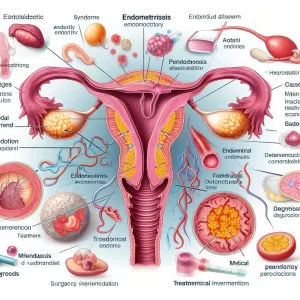What is Premenstrual Syndrome?
The term premenstrual syndrome (PMS) describes a variety of physical and emotional changes that may occur in a woman in the days before her menstrual period begins. This condition is very common, and affects the majority of menstruating women in one way or another. These changes include a low mood, increased appetite, tender breasts, mood changes, irritability and acne. The severity of symptoms varies from person to person. These symptoms tend to repeat in a predictable pattern before a period. Treatment involves lifestyle changes and medications which help to manage the menstrual cycle. Although PMS cannot be cured, the symptoms can usually be well managed.
Risks
The normal menstrual cycle is controlled by rising and falling levels of the hormones estrogen and progesterone. These hormones are responsible for developing and releasing the ova (eggs) and preparing the body for pregnancy, in the case that the egg becomes fertilized. If no fertilization occurs, menstrual bleeding occurs. Although the exact cause of premenstrual syndrome is not well understood, it’s likely that these changing hormone levels are responsible for the symptoms of premenstrual syndrome. This condition is very common, and affects the majority of menstruating women in one way or another.
Symptoms
Typical symptoms of PMS include emotional and physical symptoms. These vary widely from person to person, and may range from mild to causing problems with one’s work or home life. Emotional symptoms include mood swings, irritability, sleeping difficulties, food cravings and poor concentration. Physical symptoms include bloating, breast tenderness, decreased energy, weight gain, nausea, swelling of the feet, impaired concentration and headaches.
Diagnosis
The diagnosis usually is made based on the symptoms and their relation to the menstrual period. Usually no tests are needed to confirm the diagnosis. A diary of symptoms can be helpful to make the diagnosis.
Treatment
The treatment involves managing the symptoms. This may be achieved by making lifestyle changes or with medications. Regular exercise, having a good support network and learning relaxation techniques may be helpful in reducing symptoms. Some medications are helpful, including the (oral contraceptive) pill, and low dose anti-depressant medications. In severe cases, surgical removal of the ovaries may be an option. This causes infertility, so it is most appropriate for women who are not planning to become pregnant.
Prevention
Keeping a symptom diary may help to recognize days in the cycle which are associated with worse symptoms, and being able to anticipate these may help to manage these better.
**Q: What is Premenstrual Syndrome (PMS)?**
**A:** Premenstrual Syndrome (PMS) is a common condition that affects physical, emotional, and behavioral changes in individuals during the luteal phase of the menstrual cycle, which occurs approximately 7-10 days before the onset of menstruation. These symptoms can range in severity and may last for a few days or up to two weeks.
**Q: Who is Affected by PMS?**
**A:** PMS is estimated to affect up to 90% of women during their reproductive years. The severity of symptoms can vary significantly, with around 20-30% of women experiencing moderate to severe symptoms that impact daily functioning.
**Q: What Causes PMS?**
**A:** The exact cause of PMS is not fully understood, but it is believed to be linked to fluctuations in hormone levels during the menstrual cycle, particularly estrogen and progesterone. These hormonal changes can affect the brain and body, leading to a variety of symptoms.
**Q: What are the Symptoms of PMS?**
**A:** The symptoms of PMS can be diverse and vary from individual to individual. Some common physical symptoms include:
* Breast tenderness
* Bloating
* Headaches
* Fatigue
* Acne breakouts
* Cramps
* Food cravings
Emotional and behavioral symptoms may include:
* Irritability
* Mood swings
* Anxiety
* Depression
* Difficulty concentrating
* Social withdrawal
**Q: How is PMS Diagnosed?**
**A:** PMS is typically diagnosed based on the individual’s symptoms and their timing in relation to the menstrual cycle. A healthcare professional may ask questions about symptoms, perform a physical exam, and review menstrual records.
**Q: What are the Treatment Options for PMS?**
**A:** Treatment for PMS aims to relieve symptoms and improve quality of life. Some common approaches include:
* Lifestyle changes: Regular exercise, healthy diet, and stress management techniques can help reduce symptoms.
* Over-the-counter pain relievers: Non-steroidal anti-inflammatory drugs (NSAIDs) can help relieve pain and inflammation.
* Hormonal therapy: Birth control pills, patches, or rings can regulate hormone levels and reduce PMS symptoms.
* Selective serotonin reuptake inhibitors (SSRIs): These antidepressants may help alleviate emotional symptoms such as anxiety and depression.
**Q: When Should I Seek Professional Help for PMS?**
**A:** Seek professional help if:
* PMS symptoms are severe and interfere with daily activities
* Symptoms are new or worsen over time
* Emotional symptoms are persistent or overwhelming
* Over-the-counter remedies do not effectively relieve symptoms
One comment
Leave a Reply
Popular Articles








#PremenstrualSyndrome #PMS